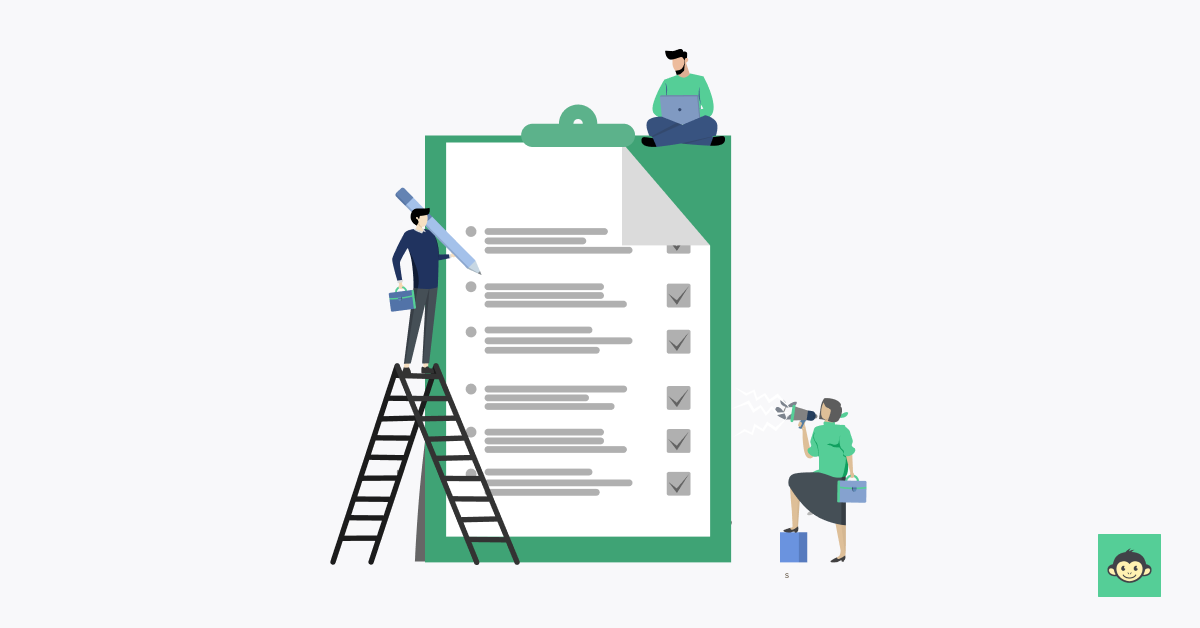What is the purpose of employee engagement: Tips and tricks to improve engagement

Employee engagement is more than just a buzzword in today's workplace. It is a crucial factor that directly impacts organizational success and employee well-being.
Studies have shown that highly engaged employees are 21% more productive and are 87% less likely to leave their organizations compared to their disengaged counterparts.
But what exactly is the purpose of employee engagement? Why is it so important for organizations to prioritize and invest in strategies that improve engagement levels?
In this blog, we will delve into the core purpose of employee engagement and provide you with valuable tips and tricks to enhance and boost employee engagement within your organization.
Table of contents:-
- Why is employee engagement important?
- What are the 5 dimensions of engagement?
- What are the key drivers of employee engagement?
- Purpose of employee engagement initiatives
- Key objectives of employee engagement
- How to measure and improve employee engagement?
- How can employee engagement surveys be of help in measuring engagement?
- Why do you need an employee engagement committee to ensure and enforce employee engagement initiatives?
Why is employee engagement important?

Employee engagement is of paramount importance for organizations as it directly impacts productivity, performance, and overall business success. Here are some key reasons highlighting the importance and benefits of employee engagement:
Increased productivity
Engaged employees are more motivated, focused, and committed to their work. They go the extra mile, consistently putting in discretionary effort, resulting in increased productivity levels. Engaged employees take ownership of their tasks, strive for excellence, and actively contribute to achieving organizational goals.
Improved employee satisfaction
When employees feel engaged, valued, and connected to their work and the organization, their job satisfaction levels soar. Engaged employees are more likely to have a positive attitude, enjoy their work, and experience a sense of fulfillment. Higher job satisfaction leads to reduced turnover rates and a more stable and engaged workforce.
Enhanced innovation and creativity
Engaged employees are more inclined to think creatively, share ideas, and contribute to innovation within the organization. They feel empowered to take calculated risks and propose novel solutions to challenges.
A culture of engagement fosters an environment where new ideas are encouraged, leading to improved problem-solving and innovation.
Better employee retention
Engaging employees significantly reduces the risk of turnover. When employees feel valued, supported, and connected to the organization, they are more likely to stay committed for the long term. This reduces recruitment and training costs while promoting stability within the workforce.
Stronger employee-organizational alignment
Employee engagement helps align employees' values, goals, and aspirations with the organization's mission and vision.
Engaged employees understand how their roles contribute to the larger picture and are more likely to embrace the organization's objectives. This alignment creates a sense of purpose and boosts overall organizational performance.
Improved customer satisfaction
Engaged employees provide better customer service and experiences. Their positive attitude, commitment, and enthusiasm translate into higher customer satisfaction levels.
Engaged employees understand the importance of customer-centricity and strive to deliver exceptional service, positively impacting the organization's reputation and customer loyalty.
Positive organizational culture
Employee engagement contributes to fostering a positive organizational culture. Engaged employees serve as advocates for the organization, promoting a collaborative, supportive, and inclusive work environment. A positive culture attracts top talent, enhances teamwork, and boosts overall employee morale.
Adaptability to change
Engaged employees are more adaptable and resilient to a successful business in the face of change. They embrace challenges, seek opportunities to learn and grow, and readily adapt to new processes or technologies. Their engagement helps drive successful organizational change initiatives and ensures smooth transitions.
In summary, employee engagement is essential for organizations to thrive. It boosts productivity, job satisfaction, innovation, retention, customer satisfaction, and overall organizational performance.
By investing in strategies to foster employee engagement, organizations can create a positive work environment that attracts and retains top talent, drives growth, and achieves long-term company success together.
What are the 5 dimensions of engagement?

The five dimensions of engagement, as identified by the Gallup organization, are:
Meaning: This dimension reflects the employee's sense of purpose and understanding of how their work contributes to the organization's goals. Employees who find meaning in their work are motivated, passionate, and driven to make a difference.
Autonomy: Employee autonomy refers to the degree of independence and decision-making authority employees have in their work. When employees have autonomy, they feel empowered to take ownership, make decisions, and use their skills and expertise to accomplish their tasks.
Growth: The growth dimension focuses on the opportunities employees have for personal and professional development. Engaged employees desire continuous growth, seek learning opportunities, and are supported in their career advancement within the organization.
Impact: Impact measures the extent to which employees feel their contributions are recognized and have a meaningful impact on the organization's success. Engaged employees understand how their work directly affects outcomes, and they receive feedback and recognition for their achievements.
Connection: Connection reflects the quality of relationships and sense of belonging that disengaged employees may experience within their work environment. Engaged employees have strong connections with their colleagues, supervisors, and the organization as a whole. They feel supported, respected, and part of a cohesive team.
These dimensions provide a comprehensive framework for understanding and assessing employee engagement. By focusing on these dimensions, organizations can develop strategies to enhance employee engagement and create an environment where employees feel motivated, valued, and fulfilled in their work.
What are the key drivers of employee engagement?

The key drivers of high employee engagement can vary depending on the organization and its specific context. However, some common factors tend to contribute to higher levels of employee engagement. Here are a few key drivers:
Effective leadership
Leadership plays a critical role in employee engagement. When leaders demonstrate transparency, communicate effectively, and provide clear direction, employees feel supported and motivated to perform at their best. Trust and respect between leaders and employees are essential drivers of engagement.
Opportunities for growth and development
Employees are more engaged when they see a clear path for growth and have access to learning and development opportunities. Organizations that invest in employee training, provide career advancement prospects, and encourage continuous learning foster higher levels of engagement.
Recognition and reward
Recognizing and appreciating employees' contributions is crucial for increasing employee engagement. Regular feedback, meaningful recognition programs, and fair compensation and benefits packages contribute to a sense of value and satisfaction among employees.
Work-life balance
A healthy work-life balance is a key driver of engagement. Organizations that prioritize employee well-being, offer flexible work arrangements, and promote a supportive culture that respects work-life boundaries tend to have more engaged and satisfied employees.
Communication and feedback
Open and transparent communication channels are vital for engagement. Employees want to feel informed about all company goals and updates, are involved in decision-making processes, and have opportunities to provide feedback. Regular feedback and two-way communication channels help employees feel heard and valued.
Positive work environment
A positive work environment, characterized by collaboration, respect, and inclusivity, contributes to higher employee engagement strategies and levels. Organizations that foster a sense of community, encourage teamwork, and prioritize employee well-being create an environment where employees feel motivated and engaged.
Meaningful and challenging work
Employees are more engaged when they find their work meaningful and feel challenged. Providing employees with meaningful tasks, opportunities to make an impact, and assignments that leverage their skills and expertise fosters higher levels of engagement.
Organizational values and purpose
Employees are more engaged when they align with the organization's values and purpose. When employees believe in the mission and vision of the organization, they are more likely to be engaged and motivated to contribute to its success.
These key drivers of employee engagement highlight the importance of leadership, growth opportunities, recognition, work-life balance, communication, a positive work environment, meaningful work, and alignment with organizational values.
By focusing on these drivers, organizations can create an environment that fosters high levels of employee engagement and drives overall performance and success.
Purpose of employee engagement initiatives

The purpose of employee engagement initiatives is to create a work environment where employees feel motivated, committed, and connected to their work and the organization. These initiatives are designed to enhance employee satisfaction, productivity, and overall performance. Here are the main purposes of implementing employee engagement initiatives:
Boosting employee satisfaction
Employee engagement initiatives aim to improve job satisfaction by addressing the needs and expectations of employees. When employees are satisfied with their work, they are more likely to be motivated, loyal, and committed to the organization.
Increasing employee motivation
Engaged employees are highly motivated to perform their best. Employee engagement initiatives focus on providing the necessary resources, support, and recognition to fuel employee motivation. This leads to higher levels of productivity, efficiency, and quality of work.
Enhancing employee retention
Motivated employees are more likely to stay with the organization for the long term. Employee engagement initiatives help create a positive work environment that fosters loyalty and reduces employee turnover rates. This saves the organization the costs associated with recruitment, onboarding, and training of new employees.
Improving team collaboration and communication
Employee engagement initiatives encourage collaboration, teamwork, and open communication within the organization. Engaged employees are more willing to share knowledge, support their colleagues, and contribute to a positive and productive work culture.
Driving innovation and creativity
Engaged employees feel empowered to think creatively, share ideas, and contribute to innovation within the organization. Employee engagement initiatives create platforms for idea generation, feedback, and continuous improvement, which lead to innovative solutions and better business outcomes.
Strengthening organizational culture
Employee engagement initiatives play a crucial role in shaping and reinforcing the desired organizational culture. By aligning employee values and behaviors with the organization's values, these initiatives promote a positive work culture, foster a sense of belonging, and enhance employee morale.
Enhancing customer experience
Engaged employees deliver better customer experiences. When employees are engaged, they are more likely to go above and beyond to meet customer needs, resulting in increased customer satisfaction, loyalty, and retention.
Driving organizational performance
Ultimately, the purpose of employee engagement initiatives is to drive overall organizational performance. Engaged employees are more productive, innovative, and customer-focused, leading to improved business outcomes, increased revenue, and a competitive advantage in the market.
By prioritizing employee engagement initiatives, organizations create an environment where employees thrive, leading to improved job satisfaction, increased productivity, higher retention rates, and overall business success.
Key objectives of employee engagement

The key objectives of employee engagement are to enhance job satisfaction, foster employee motivation, improve communication and collaboration, develop a positive work culture, enhance employee development and growth, recognize and reward employee contributions, improve employee well-being, and drive organizational performance.
These objectives aim to create a supportive work environment where employees feel valued, motivated, and connected to the organization, resulting in increased employee productivity, retention, and overall business success.
How to measure and improve employee engagement?

Measuring and improving employee engagement requires a systematic approach. Here are the steps to effectively measure and improve employee engagement:
Conduct employee surveys: Use well-designed surveys to gather quantitative and qualitative data on employee engagement levels. Ask questions related to job satisfaction, communication, recognition, development opportunities, and overall employee experience.
Analyze survey results: Analyze survey responses to identify patterns and areas of improvement. Look for trends, high and low engagement areas, and common concerns or suggestions shared by employees.
Act on feedback: Share the survey results with employees, demonstrating transparency and commitment to improvement. Develop action plans to address the identified issues, involving employees in the process.
Enhance communication: Establish regular channels for two-way communication to keep employees informed, address concerns, and gather feedback. Encourage open dialogue, active listening, and transparency in organizational communication.
Provide development opportunities: Invest in employee development programs, training, and career advancement opportunities. Support employees in their professional growth, helping them acquire new skills and progress in their careers.
Recognize and reward: Implement recognition programs to appreciate employee efforts and achievements. Recognize employees for their contributions, both formally and informally, to foster a culture of appreciation and motivation.
Promote work-life balance: Encourage work-life balance by offering flexible work arrangements, promoting wellness initiatives, and supporting employees' personal needs. Prioritize employee well-being to prevent burnout and promote engagement.
Foster a positive work culture: Cultivate a positive work environment by promoting teamwork, collaboration, and inclusivity. Encourage strong leadership, employee empowerment, and a supportive culture where everyone feels valued and respected.
Measure progress: Regularly reassess employee engagement through surveys, track progress against the identified areas for improvement, and measure the impact of implemented initiatives.
Continuously improve: Employee engagement is an ongoing process. Continuously seek feedback, adapt strategies, and refine engagement initiatives based on employee input and changing organizational needs.
By following these steps, organizations can measure employee engagement effectively, identify areas for improvement, and implement targeted strategies to enhance engagement levels, leading to a more motivated, productive, engaged employee and satisfied workforce.
How can employee engagement surveys be of help in measuring engagement?

Employee engagement surveys are valuable tools for measuring engagement within an organization. Here's how these surveys can help measure employee engagement:
Quantitative measurement: Employee engagement surveys use standardized questionnaires with rating scales to quantify engagement levels. By analyzing the survey responses, organizations can obtain quantitative data on engagement levels across different departments, teams, or demographic groups.
Identify engagement drivers: Surveys help identify key drivers of engagement within the organization. By asking specific questions about various aspects of work, such as job satisfaction, communication, growth opportunities, and recognition, organizations can pinpoint areas that have the most significant impact on employee engagement.
Assess perceptions and feedback: Surveys provide a platform for employees to express their perceptions, opinions, and feedback anonymously. Employees can share their thoughts on workplace conditions, leadership, company culture, and other factors that influence their engagement. This feedback can provide valuable insights into areas that require improvement.
Benchmarking and comparison: Employee engagement surveys often include benchmarking data that allows organizations to compare their engagement levels with industry standards or other organizations. This provides context and helps identify areas where the organization may be lagging or excelling in terms of employee engagement statistics.
Actionable insights: Surveys generate data that can be analyzed to gain actionable insights. By examining survey results, organizations can identify specific areas for improvement and develop targeted strategies to address the challenges and enhance engagement levels.
Tracking progress over time: Conducting employee engagement surveys periodically allows organizations to track changes in engagement levels over time. By comparing survey results from different periods, organizations can gauge the effectiveness of implemented initiatives and identify trends in engagement.
Employee involvement and ownership: Involving employees in the survey process gives them a sense of ownership and demonstrates that their opinions matter. This involvement fosters a culture of open communication and employee participation, leading to increased engagement.
Decision-making support: Survey results provide data-driven insights that support decision-making at various levels within the organization. The findings can help prioritize initiatives, allocate resources, and guide the development of targeted action plans to improve engagement.
By leveraging employee engagement surveys, organizations can gather valuable data, identify engagement drivers, assess perceptions and feedback, track progress, and gain actionable insights to enhance engagement levels. It enables organizations to make informed decisions and implement targeted strategies to create a more engaged and productive workforce.
Why do you need an employee engagement committee to ensure and enforce employee engagement initiatives?

An employee engagement committee is crucial to ensure and enforce employee engagement initiatives because it brings together representatives from different levels and departments within the organization.
This committee serves as a dedicated team responsible for driving engagement efforts, gathering employee feedback, implementing initiatives, and monitoring progress. By involving employees in the committee, it ensures their voices are heard, fosters a sense of ownership, and promotes a culture of engagement.
The committee plays a vital role in ensuring the success and sustainability of employee engagement initiatives by coordinating efforts, providing leadership, and holding the organization accountable for maintaining high levels of what employee engagement is important for.
The purpose of employee engagement goes beyond mere job satisfaction. It encompasses creating an environment where employees feel connected to their work, motivated to contribute their best efforts, and aligned with the organization's goals and values. When employees are engaged, they become advocates for the organization, driving productivity, innovation, and customer satisfaction.



